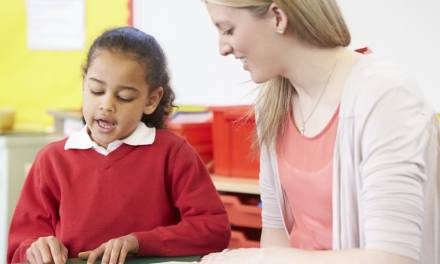Teaching as a whole has broadened, especially in recent years and online learning has opened up endless possibilities to help children reach their education potential. But, what does a day look like for an online teacher in comparison to a teacher in a mainstream school setting?
 We thought it was a good idea to give you some insight into what teaching online is truly like from an online alternative provision perspective. Our maths teacher, Steph Lowes, sat down and discussed her day-to-day and the impact teaching online can truly have on transforming a child’s experience with education.
We thought it was a good idea to give you some insight into what teaching online is truly like from an online alternative provision perspective. Our maths teacher, Steph Lowes, sat down and discussed her day-to-day and the impact teaching online can truly have on transforming a child’s experience with education.
Q1. First, talk to me about your teaching history before becoming an online teacher and when you became an online teacher
I did the three-year undergraduate route into teaching, which was maths with education and qualified teacher status, and I graduated in 2017. I started working at a larger-than-average-sized secondary school. It was part of a small, but expanding Multi-Academy Trust and I was there for one and a half years. There was a high proportion of disadvantaged students and it was in the top 10% of the most deprived areas in England.
After that, I moved to an average-sized secondary school, again, with a high level of deprivation and a high proportion of pupil premium students. I worked there for three years during which time I mentored ITTs and ECTs. I went through the whole lockdown, working from home at my kitchen table and I was part of the teacher-assessed grades process. Teaching through lockdown was difficult as everything changed overnight. We were not prepared. Initially, everything was trial and error. In the second lockdown, I taught the whole of year seven at once.
Q2. What happens when you come into work and get logged on to EDClass?
When I arrive at the office I’ll log onto the computer and make sure the alert monitoring screen and student stream page is on. The alert screen tells us if a student answers negatively on a questionnaire or if they press the alert button which forms part of our safeguarding procedures.
I start at 8.00 am and finish at 4.30 pm but some teachers start at 8.30 am and finish at 5.00 pm. Students can be timetabled from 8.30am, but the majority of students don’t start till 9.00 am. We get a half an hour lunch break between 12.00 pm – 2.00 pm and get regular breaks from our desks. If there was a safeguarding issue we would deal with it immediately. We also wouldn’t walk away mid-conversation with a learner, the learners are our priority.
The teachers are timetabled in different roles throughout the day. This includes:
- subject-specific support
- pastoral support
- planning and recording videos
- creating and editing slide-based lessons
- monitoring and increasing engagement
- marking and feedback and mirroring schemes of work provided by schools
We use a ‘hands-up’ system for subject-specific support. The learners work independently but we are here if they need support with anything. We check the students’ reports and ask them subject-specific questions to check their understanding. We constantly check students are engaging and understanding the content so they can progress. We then also take some time to set personalised learning pathways for students informed by progress assessments.
It’s good because students can learn at their own pace and the support is personalised to the individual learner. One of the main problems when teaching an entire cohort online in lockdown was that we were trying to teach lessons on a ‘one size fits all’ basis. You couldn’t really check that they’d understood the content you taught them.
Q3. How do you spot if a student isn’t engaging well online?
We’ll look at reports and monitor the cameras. We check to see if they are meant to be accessing timetabled lessons and if they are not engaging we can step in. We can also listen to their environment to hear as well as see what is going on.
We need their cameras to be on, especially if they are a safeguarding concern. This can be a battle if students refuse to be on camera but we inform the school if this situation arises.
We can see how long a learner spends in a lesson, which includes both active and idle time, as well as answers and scores.
Q4. How do you overcome lapses in behaviour and poor judgement of students when online teaching?
We try to look for the root cause of their behaviour and think beyond the behaviour displayed. A student doesn’t just behave badly, there’s a reason for it. It is important that schools disclose as much information as they can about the learner, as this can provide insights into adverse childhood experiences. We always try to be empathetic and we use the displayed behaviour as a learning opportunity. We can also assign specific behaviour repair lessons.
We deal with our learners one-to-one so there isn’t an audience, as you would have in a classroom. Learners are not given the opportunity to influence the behaviour of other learners, and vice versa. As every scenario is different, behaviour repair work is personalised to the learner so you can work more effectively to improve their behaviour.
Q5. How do you ensure students are safe online?
We have eyes-on learning and the students have a safety questionnaire when they first log in, in which the answers are set to ‘yes’ as a default. So, it might be things like ‘are you warm’, all the way to ‘are you safe’? If they answer ‘no’ it makes an alarm go off in the office. School will always be contacted and we will communicate with the learner and address the question.
Learners have an alert button which they can press if they feel they are unsafe or in danger. It is a two-step process so is intentional when pressed. We then communicate with that learner and we only close down the alert once we hear back from school.
If required, we can get the emergency services involved as we have the What3Words and the IP addresses for the location of the learner. We can also make referrals to external support services such as MASH and Prevent.
Q6. How do you support our students with mental health and SEND requirements?
With online learning, the students can work at their own pace, so I think that helps quite a lot of learners with mental health challenges or SEN requirements.
For SEND students there is the option for coloured overlays on the computer so you can change the slide colour and the text colour, which can help with visual stress, and you can also change the font and the font size. They’ve also got screen readers if they need help with reading. The lessons are broken down into small steps but we can also break it down into even smaller steps through subject-specific support.
The main aim is to reintegrate learners back into school. We aim to reduce gaps in knowledge because if a learner has been out of school for a while this can increase the anxiety around reintegration. They can also get their attendance marks with us – code B. When they are reintegrating we’ll be with them along the way and have conversations about how they are feeling and will support them through this process.
Q7. What do you like about online teaching so much?
I like the freedom to be able to build meaningful relationships with learners and actually feel like I am making a real difference to their life chances. I mean, you could say the same in a school, but I think because of the types of learners we work with, it makes it even more rewarding.
We had a learner who had been involved with the police and has gone on to study their chosen college course. If we weren’t there for them, would they have had that opportunity? It’s not just about achieving qualifications, it’s about teaching them responsibility and preparing them for adult life.
Q8. How does online teaching compare to traditional face-to-face teaching?
In school, there was more of a mental load. Whereas, as an online teacher when you go home, you can switch off. I’m not saying I don’t necessarily think about work at home, because I do, as I am passionate about what I do. However, it is less mentally draining despite having an increased awareness of adverse childhood experiences. It is definitely more rewarding as we celebrate the achievements, no matter how small they may initially seem. Logging on that day is a big achievement for some of these learners.
Interested in implementing an effective online alternative provision?
An online alternative provision has the potential to support vulnerable students in a setting they are most comfortable with. An aim of positive reintegration should always be pushed and supporting students through online learning can be achieved if the correct measures are implemented.
If you would like to learn more about EDClass, and how it all works or even apply, call 01909 568338, send an email to mail@edclass.com or enquire for more information here.









